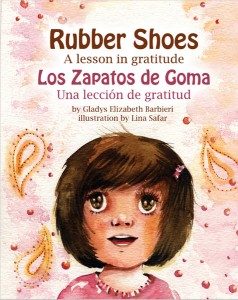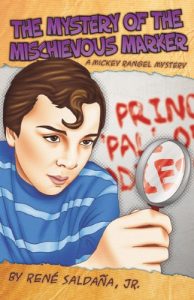 “In this bilingual counting picture book, a young boy counts to fourteen in anticipation of his birthday party: one piñata filled with candy; two hours until the party; three tables set for all of the guests, etc.”
“In this bilingual counting picture book, a young boy counts to fourteen in anticipation of his birthday party: one piñata filled with candy; two hours until the party; three tables set for all of the guests, etc.”
United States
Materials from United States of America
I Am Rene, The Boy/ Soy Rene, El Nino

When René learns that in the United States his name is also a girl’s name, he does some research and relates the name’s meaning and letters to his homeland of El Salvador and the things that make him special.
Let’s Salsa / Bailemos Salsa
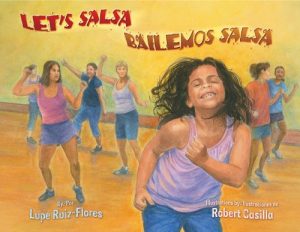 Estella can’t help but giggle when she sees her neighbors, Dona Rosa and Dona Maria, shaking their hips while dancing and sweating at an exercise class at the community recreation center. A few days later, when her mother complains about gaining weight, Estella encourages her to join the class.
Estella can’t help but giggle when she sees her neighbors, Dona Rosa and Dona Maria, shaking their hips while dancing and sweating at an exercise class at the community recreation center. A few days later, when her mother complains about gaining weight, Estella encourages her to join the class.
Let’s Salsa / Bailemos Salsa has been discussed in My Take/Your Take for September 2020.
Béisbol!
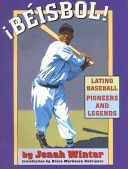
Presents profiles of fourteen Latino baseball players who, from 1900 through the 1960s, were pioneers of the sport in their home countries and the United States.
Cada Niño/Every Child
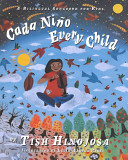
In “Cada Nino / Every Child, “acclaimed singer/songwriter Tish Hinojosa presents eleven bilingual songs especially for children. Some are playful toe-tappers like “The Barnyard Dance / El Baile Vegetal” where all the peas and greens and cabbage and beans shimmy in the pale moonlight; some are ballads, telling stories about the Mexican Revolution; while some are lullabies, sweet and dreamy, or celebrations of a grandmother’s love. But all of the songs will teach children about the rich mixture of Latino and American culture and tradition that is spreading out from the border across the United States. Every song is presented in both Spanish and English. Lyrics, music and guitar chords will help kids, parents and teachers to sing and play these wonderful songs themselves. Tish Hinojosa grew up in San Antonio in a house full of music. Moving with equal grace through folk, country, pop and Hispanic idioms, Tish’s music is known for dissolving the boundaries between cultures, languages and musical genres. Her CD “Cado Nino /Every Child “garnered a Parent’s Choice Gold Award and an award from the National Association of Parenting Publications. Hinojosa’s music has been widely praised in the national press and she has appeared on “Austin City Limits, Good Morning America, ” and at the White House for former President and Mrs. Clinton. Tish lives in Austin, Texas. Lucia Angela Perez illustrated her first book, “Little Gold Star/ Estrellita de Oro, “with her mother, Gloria Osuna Perez. The book and the poignant story of this mother and daughter was featured on National Public Radio. “Little Gold Star “was chosen by Nick Jr. Magazine as one of the 30 best books of the year 2000. “Cada Nino / Every Child “is Lucia Angela Perez’ second book. Lucia lives in Fort Worth, Texas.
Poems to Dream Together / Poemas Para Sonar Juntos
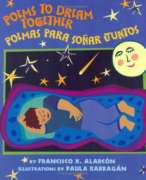
A collection of poems in English and Spanish discusses imagination, dreams, family, and growing up in California and in Mexico.
Rubber Shoes / Los Zapatos De Goma: A Lesson in Gratitude / Una Leccin De Gratitud
The Mystery Of The Mischievous Marker
The Cucuy Stole My Cascarones/El Coco Me Rob Los Cascarones
Mighty Monster Mysteries! Roberto and his mother made thirty dozen confetti-filled eggs, or cascarones, for his birthday party. Roberto can’t wait to crack the hollowed, painted and confetti-stuffed eggs over his friends’ heads. But, when he goes to the kitchen to get the cascarones, they’re gone! The only clue they ever existed is a trail of confetti that leads to a shadow.
Home at Last
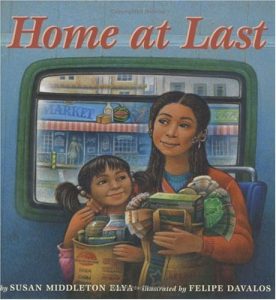 Ana Patino is adjusting well to her new life in the United States, but her mother is having problems because she doesn’t know English. When one of the babies falls ill, Mama tries to get help, but no one can understand her. Convinced that she needs to learn the new language, Mama agrees to take English lessons. As Mama gains new language skills, she also develops a sense of confidence and belonging.
Ana Patino is adjusting well to her new life in the United States, but her mother is having problems because she doesn’t know English. When one of the babies falls ill, Mama tries to get help, but no one can understand her. Convinced that she needs to learn the new language, Mama agrees to take English lessons. As Mama gains new language skills, she also develops a sense of confidence and belonging.

